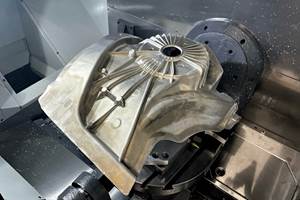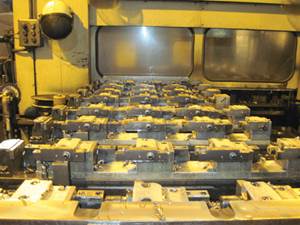Lights-Out With A Lighter Commitment
For this integrated flexible pallet cell, the machines and the pallet system came from different suppliers. The shop is not locked into any supplier for adding machining centers later.
A “lights out” process is not entirely unattended. It gets lots of attention while the lights are still on.
David Mitchell illustrates this. A machinist in an automated age, Mr. Mitchell oversees the multi-machine flexible pallet cell at B&E Tool in Southwick, Massachusetts. One other machinist assists him with this, Scott Vanden-Bulcke. Together, the two men prioritize jobs, anticipate tooling needs for jobs that are many hours away, and generally prep, set up and attend to all the details of jobs that will run not just while they are in the building, but also long after everyone has left.
Mr. Mitchell therefore augments the traditional machinist’s understanding of geometry and metalworking with additional aptitudes for organization and logistics. He is the cell’s air traffic controller, and instead of working on one job at a time, he has to look far ahead—thinking about many jobs at once.
The company, too, has developed an aptitude for lights-out machining. The cell, which is part of B&E’s Precision Aircraft Components division, machines aircraft structural components and fuel system components by hogging the parts out of titanium and aluminum. Most of these parts are ordered in small quantities, so the ability to queue a series of small-quantity jobs to run after dark, with no employees on site, has been key to letting this shop make full use of its capacity. The shop began running lights-out in this way 10 years ago, when the company made what its management now considers to have been a limiting decision.
Specifically, the shop began machining lights-out on a machining center purchased with a dedicated pallet pool. It was, and still is, a fine machine. Within a couple of years, though, the shop encountered the limitation of this approach—the system wasn’t expandable.
The shop could have bought a flexible cell instead. The investment would have been larger, but such a system would have allowed multiple machines to share pallets, and the system could have been expanded with additional pallets or machines as needed. However, as the shop management began to contemplate more lights-out capacity, it realized that a system such as this might be limiting, too. A cell purchased complete from a single supplier would tie the shop to that supplier for expansions later. To achieve a cell that was truly flexible, the shop wanted to retain the freedom to consider many different builders’ machine tools in the future.
For this reason, B&E built its flexible machining cell using a pallet system purchased independently. Supplied by Fastems (West Chester, Ohio), the pallet system does not prefer a particular machining center, and it requires no physical connection to the machining center except for a cable to the control. B&E simply took two HMCs it already owned, had part of their guardings removed to provide access, and situated the machines in front of the Fastems system.
Later, the shop intends to expand this cell to three machines. It will buy another, larger machining center from a builder that is yet to be determined.
Pallet Positives
The pallet system currently has 32 pallets, and that number is subject to expansion, too. With tombstones providing multiple clamping faces per pallet, each individual pallet at B&E typically carries setups for multiple part numbers. In short, many part numbers’ setups are kept in place. Mr. Mitchell describes the advantages of this system compared with stand-alone machines.
First, he says, there is no longer pressure to run large batches. A stand-alone machining center with just two pallets (which is the way the cell’s machining centers were used in the past) requires setups to be taken on and off the machine as the work changes. Setup times are long. By contrast, having lots of pallets per machine allows setups to wait on the rack, with workpieces simply loaded as needed. Setup times are brief, so the shop doesn’t feel the need to run more pieces than the order requires. This saves on the amount of material and the amount of finished work that the shop has to carry in inventory.
A second advantage is that the shop no longer has to concern itself with second-shift staffing. The large number of pallets allows the queue of unattended machining jobs to be long indeed. If fewer pallets were available to the machines, then the shop would have to staff a second shift—something that has always been difficult for the shop to do. Second-shift positions tend to have high turnover. With this system, however, so long as Mr. Mitchell and Mr. Vanden-Bulcke can get the requisite number of jobs set up by day, the shop is spared the expense and uncertainly of relying on these positions.
Programs, Too
The shop’s pallet system includes pallet racks, a pallet shuttle for retrieving and moving the right pallet, two load stations where the operators load and set up work, and a cell controller.
Avoiding the need for a hardware connection to the machine tools, the pallet loading device uses parallel fingers that pick up the pallet and move it through the air the way a fork truck might. Therefore, every pallet used in this system has “wings” in the form of side extensions that are sized to this fork. Fastems provides these accessories for retrofitting to existing pallets, but B&E found it expedient just to machine the extensions itself as they are needed.
Because program storage is also a valuable part of the system, the cell controller can’t be overlooked. The controller acts as not just the program library, but also the overseer for the machining centers’ CNCs. This is where Mr. Mitchell prioritizes jobs and creates the “routes” that match the part numbers to programs and determine where the parts will end up when finished (back on the rack or waiting at a load station, for example). To avoid redundant program versions, the controller transfers a program to the machining center’s CNC only as that job is being loaded into the machine.
Sizing Up
The third machining center in the system will also benefit from this management and oversight. However, it won’t benefit from all of the other advantages that the initial two machines enjoy. Specifically, it won’t share pallets. Because it will be a bigger machine, it will have bigger pallets—in effect making the new machine with its unshared pallets a pallet-pool machine imposed into the pallet system. Does it make sense for the shop to do this?
Absolutely, Mr. Mitchell explains. First, the purchase will be cheaper than buying a machining center with its own pallet pool, because the shop has the infrastructure for moving and managing pallets already in place.
But second and more importantly, adding this larger machine to the independent pallet system will afford the shop the expandability that it overlooked with its first purchase of a pallet-pool machine. More large pallets can easily be added to the system later to serve this machine, or if need be, another large machine can be purchased to share the existing pallets. With this approach, in other words, the shop preserves the luxury of having a wide range of options available.
Related Content
Fixturing Castings Made Simple Through Adhesive Workholding
When a casting proved too malleable for traditional gripping, Thomas/Euclid Industries adopted — and succeeded with — Blue Photon adhesive workholding.
Read MoreMoving To Magnets Doubles Productivity
Moving from hydraulic to magnetic fixtures enabled this shop to reduce setup time, improve rigidity and eliminate manual operations. As a result, productivity doubled.
Read MoreMachining Vektek Hydraulic Swing Clamp Bodies Using Royal Products Collet Fixtures
A study in repeatable and flexible workholding by one OEM for another.
Read MoreParts and Programs: Setup for Success
Tips for program and work setups that can simplify adjustments and troubleshooting.
Read MoreRead Next
3 Mistakes That Cause CNC Programs to Fail
Despite enhancements to manufacturing technology, there are still issues today that can cause programs to fail. These failures can cause lost time, scrapped parts, damaged machines and even injured operators.
Read MoreThe Cut Scene: The Finer Details of Large-Format Machining
Small details and features can have an outsized impact on large parts, such as Barbco’s collapsible utility drill head.
Read More.jpg;maxWidth=970;quality=90)
.jpg;width=70;height=70;mode=crop)







.jpg;maxWidth=300;quality=90)
.png;maxWidth=300;quality=90)
.png;maxWidth=300;quality=90)



















